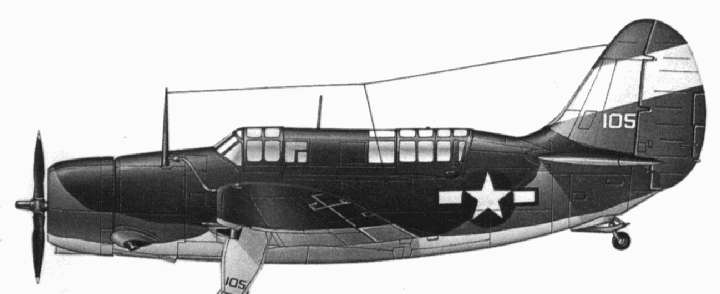

When the SBD Dauntless was introduced, the Navy was already seeking for a replacement. In August 1938, six aircraft manufacturers made offers. The Curtiss-Wright offer, a second-generation Helldiver, of which name the Navy already had had a dive-bomber, was rather conventional in nature, but incorporated some new elements. First, it was the Navy's first dive-bomber with a weapons' bay, and second, the visibility and firing arcs aft were actually blocked by the fuselage.
It also mounted a large battery of guns, four wing-mounted .50-calibers and one twin .30-caliber defensive battery in the after cockpit. In May 1939, a prototype was ordered. In 1940, a series of tests revealed a posibility of improvement, and changes to the wings and rudders were made. Problems were encountered, but the general type continued essentially unchanged to conduct tests until, on December 21st, 1941, a plane making a dive-bombing run couldn't pull up and crashed into the ground. This desaster caused a series of changes unpredencented in U.S. Navy planes, 889 major changes and thousands of detail changes. The plane coming out of the factories then, was not really resembling the original plane, but the original orders made by the Navy in 1940 remained unchanged, and the first plane of the series rolled out of the factories in late 1942, first being assigned to U.S.S. Essex in November. The first combat mission of the plane was conducted in November 1943, when Bunker Hill's planes raided Rabaul. The attack was successful, the Helldiver successful, but unwanted. Dive-bomber pilots complained about its handling, and would rather have kept their beloved Dauntless. But the Navy needed the extra striking power of the Helldiver - it carry twice as much bombs as the older plane, could mount rockets and even torpedos, and did carry an even heavier armament now than the original concept had desired - 2 x 20mm guns in the wings and a 12.7mm in the rear cockpit.
The Helldiver
had a short career, however, since a lack of targets and the increased
threat from kamikazes made the space it took up wanted for fighters, which
could bomb almost as effectively as the dive-bomber, and most carriers
retired their contingents. It remained in service with the Navy, however,
and saw some service in the French, Italian and Thai forces.
|
|
Length: 11.18 meters / 36.68 ft.
Wingspan: 14.26 meters / 46.8 ft. Crew: 2 Weight Empty: 4720 Kilograms / 10405 lbs. Weight Loaded: 6380 Kilograms / 14065 lbs. Weight Maximum: ? Armament: 2 x 20mm, one in each wing, two 227 Kilograms / 500 lbs. bombs Top Speed: 471 km/h / 295 mph Range: 3080 km / 1165 miles Ceiling: 8950 meters / 29.000 feet Climb Rate: 550 meters per minute / 1800 feet per minute |